目的状语从句和结果状语从句
- 格式:docx
- 大小:15.89 KB
- 文档页数:4
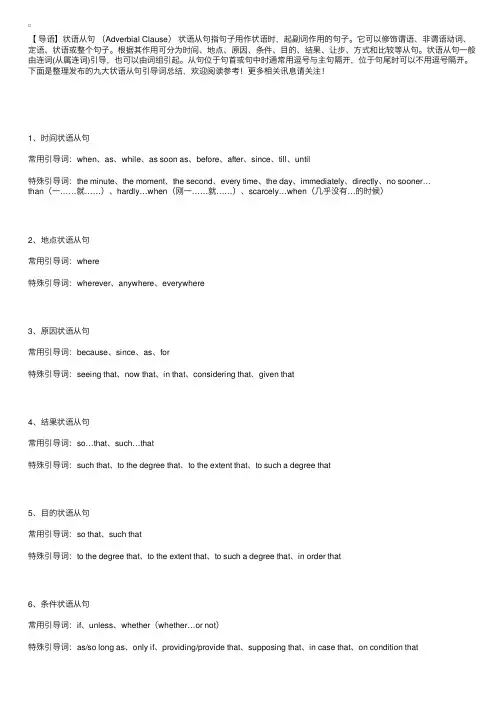
【导语】状语从句(Adverbial Clause)状语从句指句⼦⽤作状语时,起副词作⽤的句⼦。
它可以修饰谓语、⾮谓语动词、定语、状语或整个句⼦。
根据其作⽤可分为时间、地点、原因、条件、⽬的、结果、让步、⽅式和⽐较等从句。
状语从句⼀般由连词(从属连词)引导,也可以由词组引起。
从句位于句⾸或句中时通常⽤逗号与主句隔开,位于句尾时可以不⽤逗号隔开。
下⾯是整理发布的九⼤状语从句引导词总结,欢迎阅读参考!更多相关讯息请关注!1、时间状语从句常⽤引导词:when、as、while、as soon as、before、after、since、till、until特殊引导词:the minute、the moment、the second、every time、the day、immediately、directly、no sooner…than(⼀……就……)、hardly…when(刚⼀……就……)、scarcely…when(⼏乎没有…的时候)2、地点状语从句常⽤引导词:where特殊引导词:wherever、anywhere、everywhere3、原因状语从句常⽤引导词:because、since、as、for特殊引导词:seeing that、now that、in that、considering that、given that4、结果状语从句常⽤引导词:so…that、such…that特殊引导词:such that、to the degree that、to the extent that、to such a degree that5、⽬的状语从句常⽤引导词:so that、such that特殊引导词:to the degree that、to the extent that、to such a degree that、in order that6、条件状语从句常⽤引导词:if、unless、whether(whether…or not)特殊引导词:as/so long as、only if、providing/provide that、supposing that、in case that、on condition that7、让步状语从句常⽤引导词:though、although、even if、even though特殊引导词:as(⽤在让步状语从句中必须要倒装)、while(⼀般⽤在句⾸)、no matter…、in spite of the fact that、whatever、whoever、wherever、whenever、however、whichever8、⽅式状语从句常⽤引导词:as、as if、how特殊引导词:the way9、⽐较状语从句常⽤引导词:as(同级⽐较)、than(不同程度的⽐较)特殊引导词:the more…the more…、just as…、so…、A to B is what/as C is to D、no…more than、not so much A as B。
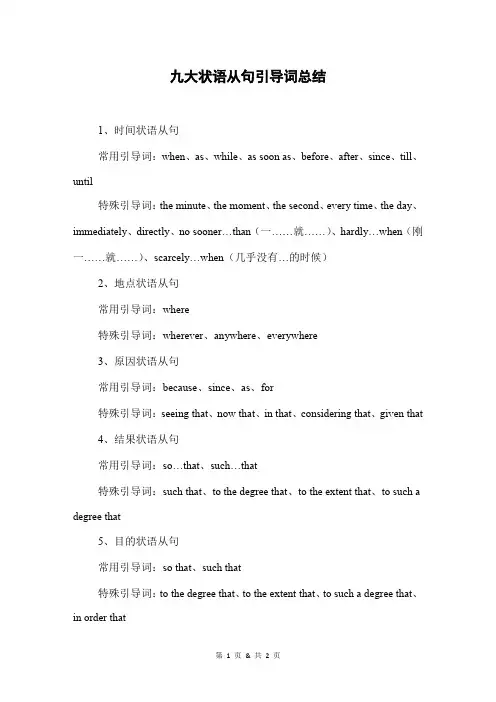
九大状语从句引导词总结
1、时间状语从句
常用引导词:when、as、while、as soon as、before、after、since、till、until
特殊引导词:the minute、the moment、the second、every time、the day、immediately、directly、no sooner…than(一……就……)、hardly…when(刚一……就……)、scarcely…when(几乎没有…的时候)
2、地点状语从句
常用引导词:where
特殊引导词:wherever、anywhere、everywhere
3、原因状语从句
常用引导词:because、since、as、for
特殊引导词:seeing that、now that、in that、considering that、given that
4、结果状语从句
常用引导词:so…that、such…that
特殊引导词:such that、to the degree that、to the extent that、to such a degree that
5、目的状语从句
常用引导词:so that、such that
特殊引导词:to the degree that、to the extent that、to such a degree that、in order that
第 1 页& 共 2 页。
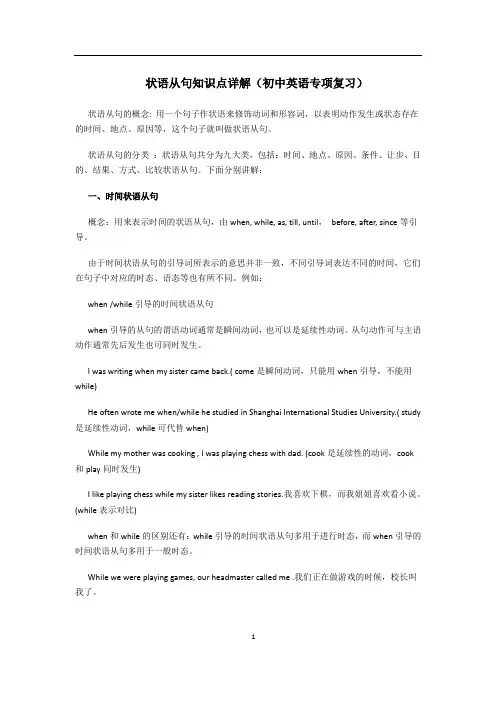
状语从句知识点详解(初中英语专项复习)状语从句的概念: 用一个句子作状语来修饰动词和形容词,以表明动作发生或状态存在的时间、地点、原因等,这个句子就叫做状语从句。
状语从句的分类:状语从句共分为九大类,包括:时间、地点、原因、条件、让步、目的、结果、方式、比较状语从句。
下面分别讲解:一、时间状语从句概念:用来表示时间的状语从句,由when, while, as, till, until,before, after, since等引导。
由于时间状语从句的引导词所表示的意思并非一致,不同引导词表达不同的时间,它们在句子中对应的时态、语态等也有所不同。
例如:when /while引导的时间状语从句when引导的从句的谓语动词通常是瞬间动词,也可以是延续性动词。
从句动作可与主语动作通常先后发生也可同时发生。
I was writing when my sister came back.( come是瞬间动词,只能用when引导,不能用while)He often wrote me when/while he studied in Shanghai International Studies University.( study 是延续性动词,while可代替when)While my mother was cooking , I was playing chess with dad. (cook是延续性的动词,cook和play同时发生)I like playing chess while my sister likes reading stories.我喜欢下棋,而我姐姐喜欢看小说。
(while表示对比)when和while的区别还有:while引导的时间状语从句多用于进行时态,而when引导的时间状语从句多用于一般时态。
While we were playing games, our headmaster called me .我们正在做游戏的时候,校长叫我了。
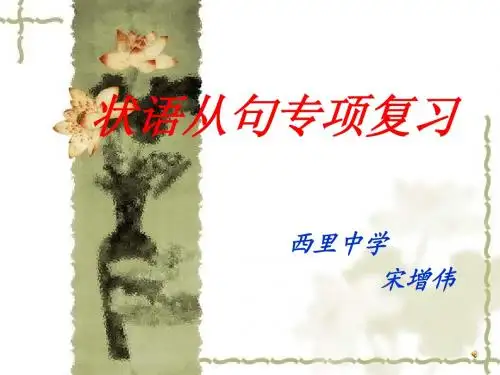

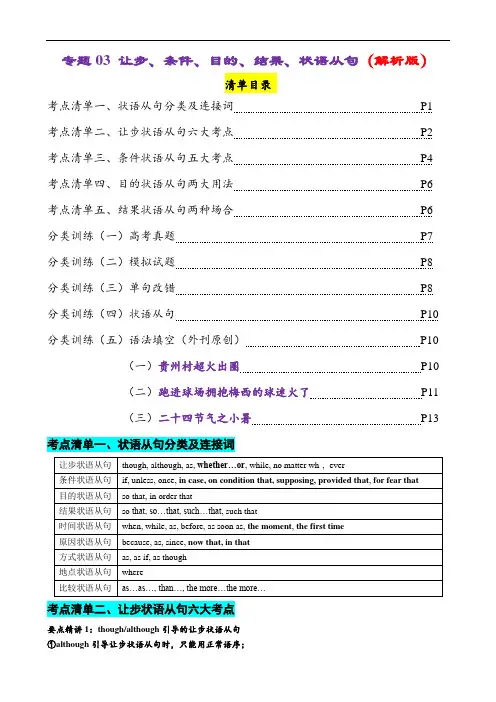
专题03 让步、条件、目的、结果、状语从句(解析版)清单目录考点清单一、状语从句分类及连接词P1 考点清单二、让步状语从句六大考点P2 考点清单三、条件状语从句五大考点P4 考点清单四、目的状语从句两大用法P6 考点清单五、结果状语从句两种场合P6 分类训练(一)高考真题P7 分类训练(二)模拟试题P8 分类训练(三)单句改错P8 分类训练(四)状语从句P10 分类训练(五)语法填空(外刊原创)P10 (一)贵州村超火出圈P10(二)跑进球场拥抱梅西的球迷火了P11(三)二十四节气之小暑P13 考点清单一、状语从句分类及连接词让步状语从句though, although, as, whether…or, while, no matter wh-, -ever条件状语从句if, unless, once, in case, on condition that,supposing, provided that, for fear that 目的状语从句so that, in order that结果状语从句so that, so…that, such…that, such that时间状语从句when, while, as, before, as soon as, the moment, the first time原因状语从句because, as, since, now that, in that方式状语从句as, as if, as though地点状语从句where比较状语从句as…as…, than…, the more…the more…考点清单二、让步状语从句六大考点要点精讲1:though/although引导的让步状语从句①although引导让步状语从句时,只能用正常语序;②though引导让步状语从句时,可用正常语序,与although替换,也可用倒装语序,与as替换。
特别③注意:although, though从句均不能与but连用。
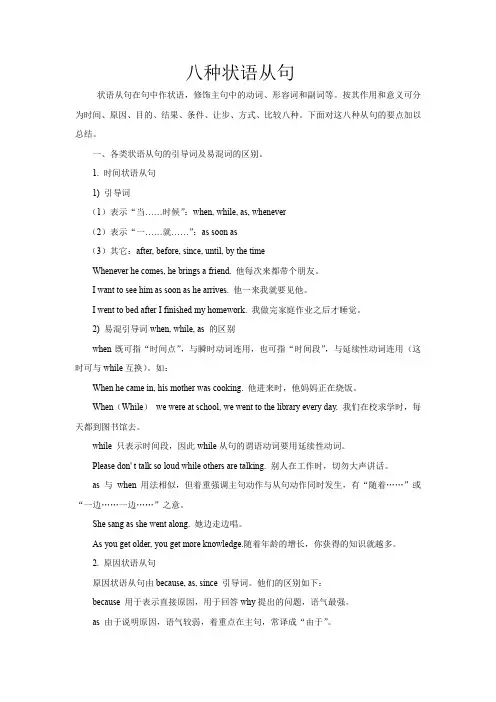
八种状语从句状语从句在句中作状语,修饰主句中的动词、形容词和副词等。
按其作用和意义可分为时间、原因、目的、结果、条件、让步、方式、比较八种。
下面对这八种从句的要点加以总结。
一、各类状语从句的引导词及易混词的区别。
1. 时间状语从句1) 引导词(1)表示“当……时候”:when, while, as, whenever(2)表示“一……就……”:as soon as(3)其它:after, before, since, until, by the timeWhenever he comes, he brings a friend. 他每次来都带个朋友。
I want to see him as soon as he arrives. 他一来我就要见他。
I went to bed after I finished my homework. 我做完家庭作业之后才睡觉。
2) 易混引导词when, while, as 的区别when既可指“时间点”,与瞬时动词连用,也可指“时间段”,与延续性动词连用(这时可与while互换)。
如:When he came in, his mother was cooking. 他进来时,他妈妈正在烧饭。
When(While)we were at school, we went to the library every day. 我们在校求学时,每天都到图书馆去。
while 只表示时间段,因此while从句的谓语动词要用延续性动词。
Please don' t talk so loud while others are talking. 别人在工作时,切勿大声讲话。
as 与when 用法相似,但着重强调主句动作与从句动作同时发生,有“随着……”或“一边……一边……”之意。
She sang as she went along. 她边走边唱。
As you get older, you get more knowledge.随着年龄的增长,你获得的知识就越多。
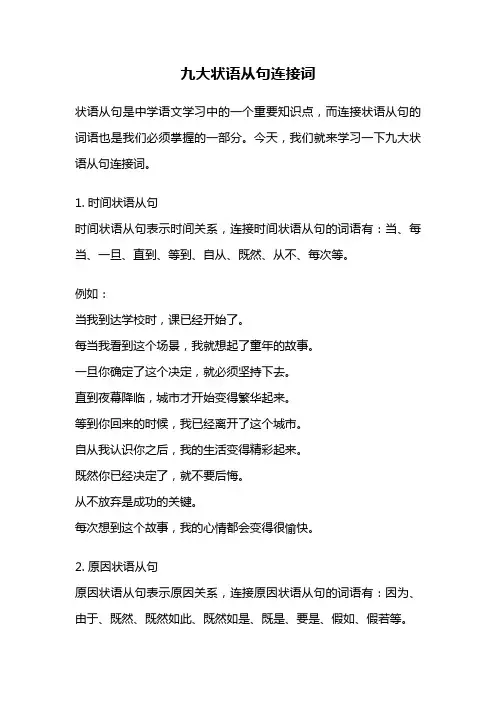
九大状语从句连接词状语从句是中学语文学习中的一个重要知识点,而连接状语从句的词语也是我们必须掌握的一部分。
今天,我们就来学习一下九大状语从句连接词。
1. 时间状语从句时间状语从句表示时间关系,连接时间状语从句的词语有:当、每当、一旦、直到、等到、自从、既然、从不、每次等。
例如:当我到达学校时,课已经开始了。
每当我看到这个场景,我就想起了童年的故事。
一旦你确定了这个决定,就必须坚持下去。
直到夜幕降临,城市才开始变得繁华起来。
等到你回来的时候,我已经离开了这个城市。
自从我认识你之后,我的生活变得精彩起来。
既然你已经决定了,就不要后悔。
从不放弃是成功的关键。
每次想到这个故事,我的心情都会变得很愉快。
2. 原因状语从句原因状语从句表示原因关系,连接原因状语从句的词语有:因为、由于、既然、既然如此、既然如是、既是、要是、假如、假若等。
例如:因为我病了,所以没去上课。
由于天气原因,我们今天不去游泳了。
既然你这么说,那我就相信你。
既然如此,我们就开始行动吧。
既然如是,那我们就按照计划行动吧。
既是好事,为什么不做呢?要是你能来,我们就可以一起去玩。
假如你愿意,我可以带你去旅游。
假若你有时间,我们可以一起去看电影。
3. 条件状语从句条件状语从句表示条件关系,连接条件状语从句的词语有:如果、假如、万一、要是、除非、只有、若是、倘若等。
例如:如果明天下雨,我们就不去旅游了。
假如你不想去,我们可以取消这个计划。
万一你走失了,我们一定会帮你找到的。
要是你想吃饭,我可以带你去尝尝当地的美食。
除非你认真学习,否则你不会有好成绩。
只有不断努力,才能有所收获。
若是你想学习,我可以给你提供一些资料。
倘若你不喜欢这个地方,我们可以去其他的地方游玩。
4. 让步状语从句让步状语从句表示虽然某种情况存在,但是结果不受影响,连接让步状语从句的词语有:虽然、尽管、即使、纵使、就算、就算是、就是等。
例如:虽然天气不好,但是我们还是决定去旅游。
尽管他很忙,但是还是抽空帮我处理了这个问题。
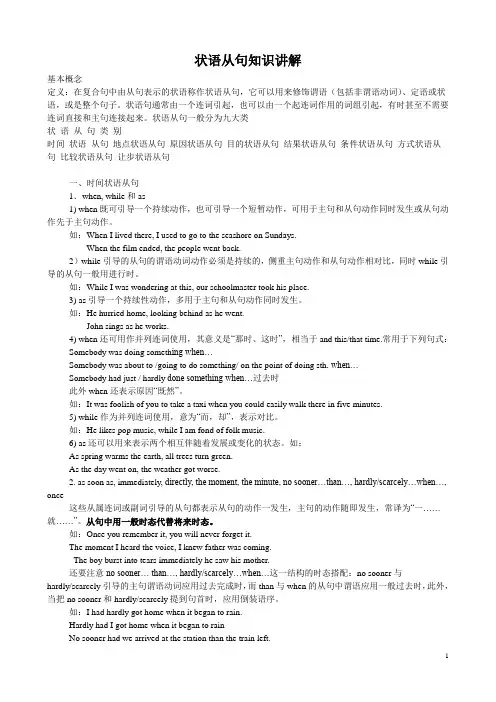
状语从句知识讲解基本概念定义:在复合句中由从句表示的状语称作状语从句,它可以用来修饰谓语(包括非谓语动词)、定语或状语,或是整个句子。
状语句通常由一个连词引起,也可以由一个起连词作用的词组引起,有时甚至不需要连词直接和主句连接起来。
状语从句一般分为九大类状语从句类别时间状语从句地点状语从句原因状语从句目的状语从句结果状语从句条件状语从句方式状语从句比较状语从句让步状语从句一、时间状语从句1.when, while和as1) when既可引导一个持续动作,也可引导一个短暂动作,可用于主句和从句动作同时发生或从句动作先于主句动作。
如:When I lived there, I used to go to the seashore on Sundays.When the film ended, the people went back.2)while引导的从句的谓语动词动作必须是持续的,侧重主句动作和从句动作相对比,同时while引导的从句一般用进行时。
如:While I was wondering at this, our schoolmaster took his place.3) as引导一个持续性动作,多用于主句和从句动作同时发生。
如:He hurried home, looking behind as he went.John sings as he works.4) when还可用作并列连词使用,其意义是“那时、这时”,相当于and this/that time.常用于下列句式:Somebody was doing someth ing when…Somebody was about to /going to do something/ on the point of doing sth. when…Somebody had just / hardly done something when…过去时此外when还表示原因“既然”。
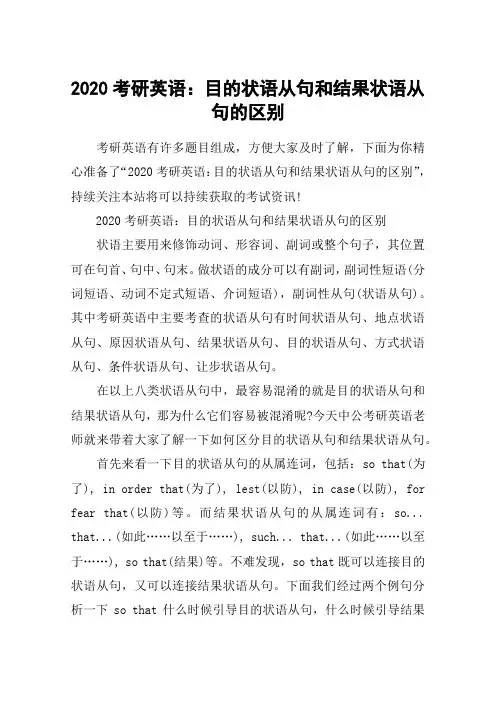
2020考研英语:目的状语从句和结果状语从句的区别考研英语有许多题目组成,方便大家及时了解,下面为你精心准备了“2020考研英语:目的状语从句和结果状语从句的区别”,持续关注本站将可以持续获取的考试资讯!2020考研英语:目的状语从句和结果状语从句的区别状语主要用来修饰动词、形容词、副词或整个句子,其位置可在句首、句中、句末。
做状语的成分可以有副词,副词性短语(分词短语、动词不定式短语、介词短语),副词性从句(状语从句)。
其中考研英语中主要考查的状语从句有时间状语从句、地点状语从句、原因状语从句、结果状语从句、目的状语从句、方式状语从句、条件状语从句、让步状语从句。
在以上八类状语从句中,最容易混淆的就是目的状语从句和结果状语从句,那为什么它们容易被混淆呢?今天中公考研英语老师就来带着大家了解一下如何区分目的状语从句和结果状语从句。
首先来看一下目的状语从句的从属连词,包括:so that(为了), in order that(为了), lest(以防), in case(以防), for fear that(以防)等。
而结果状语从句的从属连词有:so... that...(如此……以至于……), such... that...(如此……以至于……), so that(结果)等。
不难发现,so that既可以连接目的状语从句,又可以连接结果状语从句。
下面我们经过两个例句分析一下so that什么时候引导目的状语从句,什么时候引导结果状语从句。
例1:To make revision easier, leave wide margins and extra space between lines so that you can easily add words, sentences and corrections. (2008年新题型)【目的状语从句】例2:Transitions should connect one paragraph to the next so that there are no abrupt or conflict shifts. (2008年新题型)【结果状语从句】第一,目的状语从句通常表述的不是一种事实,而是一种潜在的可能性或者想要实现的愿望。
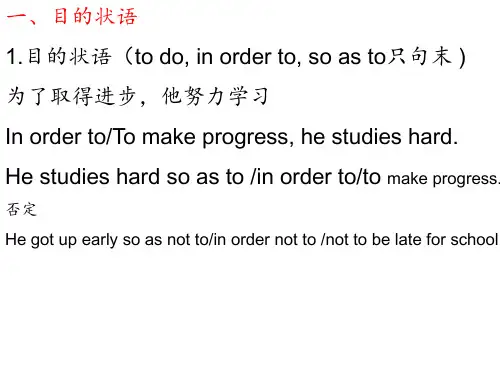
完整版)状语从句(9种全)状语从句在复合句中起到修饰主句的作用,分为时间、地点、原因、目的、结果、条件、方式、比较、让步等种类。
1.时间状语从句时间状语从句的连接词包括when。
as。
while。
after。
before。
since。
ever since。
as soon as。
once。
till。
until。
whenever。
no sooner…than。
hardly/scarcely。
when。
the moment/minute/instant/second。
every time。
each time。
any time。
the first time。
next time。
last time。
all the time。
by the time。
directly。
immediately。
instantly等。
例如,“一···就···”的句型可以用as soon as或once引导,其中as soon as侧重时间或动作先后衔接紧,而once侧重条件,表示“一旦。
”;on doing sth/on one's + n.作时间状语,例如On arriving at the n。
the thief was arrested.意为“一到达车站,这个小偷就被逮捕了。
”2.地点状语从句地点状语从句的连接词包括where。
wherever。
anywhere。
everywhere等。
例如,I'll go wherever you go.意为“你去哪儿,我就跟你去哪儿。
”3.原因状语从句原因状语从句的连接词包括because。
since。
as。
now that。
seeing that。
considering that等。
例如,Since it's raining。
we'll stay indoors.意为“因为下雨,我们将待在室内。
语法专题十四、状语从句(必考)一个句子做整句话的状语,这个句子就叫做状语从句。
状语从句根据从句在整句中表示的含义不同又可细分为时间状语从句、地点状语从句、原因状语从句、结果状语从句、目的状语从句、条件状语从句、让步状语从句、比较状语从句、方式状语从句等。
接下来我们重点复习几类状语从句。
一、时间状语从句定义和特征英语里如果用从句来表达一件事情或者一个动作发生的时间,那么这个从句就叫时间状语从句。
时间状语从句通常由when, while, as, before, after, since, as soon as, till/until等词引导。
【特征】含有时间状语从句的复合句,如果主句用一般将来时,从句用一般现在时表示将来。
(主将从现)(2021·全国·单元测试)—Daddy, when will we go out to fly a kite?—As soon as the rain _____.A. is stoppingB. stoppedC. will stopD. stops【答案】D【解析】句意:——爸爸,我们什么时候出去放风筝?——雨一停下(我们就去)。
as soon as 一……就……,引导时间状语从句,主句用一般将来时,从句用一般现在时。
故选D。
几种常见时间状语从句。
1.when引导:when表示“当……时候”。
既可表示在某一时间点发生的事,又可表示在某一时间段发生的事。
主句与从句描述的动作或事情可以是同时发生,也可以先后发生。
✧When I got home, I found my baby girl singing in the living room.当我到家时,我发现我的小女儿正在客厅里唱歌。
✧Things were different when I was a child.我小时候情况与现在不同。
【注意】when从句中的谓语动词可以是延续性动词,也可以是短暂性动词。
状语从句(Adverbial Clause)状语从句指句子用作状语时,起副词作用的句子。
它可以修饰谓语、非谓语动词、定语、状语或整个句子。
根据其作用可分为时间、地点、原因、条件、目的、结果、让步、方式和比较等从句。
状语从句一般由连词(从属连词)引导,也可以由词组引起。
从句位于句首或句中时通常用逗号与主句隔开,位于句尾时可以不用逗号隔开。
状语从句的种类状语从句可分为:1.时间状语从句;(adverbial clause of time)2.地点状语从句;(adverbial clause of place)3.原因状语从句;(adverbial clause of cause)4.条件状语从句;(adverbial clause of condition)5.目的状语从句;(adverbial clause of purpose)6.让步状语从句;(adverbial clause of concession)7.比较状语从句;(adverbial clause of comparison)8.方式状语从句;(adverbial clause of manner)9.结果状语从句。
(adverbial clause of result)[编辑本段]状语从句的时态特点一般情况下,时间和条件状语从句的谓语动词一般用“一般现在时”表示“一般将来时”,用“现在完成时”表示“将来完成时”。
例如:I will call you as soon as I arrive in Beijing. 我一到北京就给你打电话。
(这是由as soon as引导的时间状语从句,从句中的谓语动词arrive是一般现在时,表示一般将来时,决不可用will arrive)As soon as I have finished this work, I will go home. 我一完成此工作,就回家。
(从句中的谓语动词用现在完成时have finished,表示将来完成时,决不可用will have finished)If he comes back, please let me know.如果他回来了,请通知我。
英语目的状语从句结果状语从句目的状语从句是在句子中表示目的、意图或目标的从句,通常由 "in order that", "so that", "lest", "for fear that" 等引导。
例如:I study hard every day in order that I can get good grades.(我每天努力学习,以便取得好成绩。
)He gets up early every morning so that he can catch the bus.(他每天早上早起,以便能赶上公交车。
)We spoke in a low voice lest we should wake the baby.(我们低声说话,以免吵醒婴儿。
)结果状语从句是在句子中表示结果的从句,通常由"so that", "such that", "so...that...", "such...that..." 等引导。
例如:He is so talented that he can play multiple musical instruments.(他如此有天赋,以至于他可以演奏多种乐器。
)She is such a good singer that everyone loves her songs.(她是一位如此出色的歌手,以至于每个人都喜欢她的歌曲。
)The weather was so cold that we couldn't go outside.(天气太冷了,以至于我们不能出去。
)It was such a beautiful day that we decided to go for a picnic.(天气如此美好,以至于我们决定去野餐。
四、目旳状语从句在句中作目旳状语旳从句称为目旳状语从句。
常用来引导目旳状语从句旳有:so,so that,in order that, for fear that,in case(that),for the purposethat,lest等。
目旳状语从句可置于句首,句中或句尾,且从句中常有情态动词could,might,should等。
1、in order that,so that引导旳目旳状语从句in order that常用于正式文体,可置于句首,也可置于句尾,而so that往往只置于句尾,但也有置于句首旳,so that短语中有时可省略that。
Theycarved the wordson the stone so tha t/in order that the future generation should/m ight rememberwhat they had done.他们把字刻在石头上以便后裔能记住他们旳所作所为。
特别提示!:当sothat,inorder that引导旳目旳状语从句中旳主语与主句主语一致时,可将状语从句简化为不定式作状语。
如果主语不一致,转化时则需在不定式前加for短语作其逻辑主语。
上面旳例句可改为:They carved the words on the stone in order for the futuregeneration to remember whattheyhad done.2、for fear (that),in case,lest引导旳目旳状语从句for fearthat表达目旳时,意为“唯恐,以防”,in cas e意为“目旳是,以防”,lest意为“以防”Take an umbrella with you lest/in case it should rain.带着伞以防下雨。
五、成果状语从句在句中作成果状语旳从句称为成果状语从句,成果状语从句一般置于句尾。
状语从句讲义状语从句在复合句中作状语,其位置较灵活,可以在主句之前、之后或中间(放在句首时状语从句后面常用逗号,放在句末时状语从句前面往往不用逗号)。
时间状语从句when, while, as, before, after, till/until, since, as soon as地点状语从句where原因状语从句because, since, as, for方式状语从句as, as if / though目的状语从句so that, in order that结果状语从句so…that…, such…that… , so that条件状语从句if, unless,让步状语从句although, though, as一.目的状语从句的用法目的状语从句用以补充说明主句中谓语动词发生的目的。
可以由表示“为了,以便,目的是”的so that(有时省略so),in order that引导,或in case “以防”引导。
谓语常含有may, might, can, could, should, would等情态动词。
【注意】in order that与in order to的区别:in order that+从句in order to+动词原形(in order to后面加的那个不叫目的状语从句,叫目的状语)例:They both worked day and night in order that they could pay off their debt.= They both worked day and night in order to pay off their debt.他们夜以继日地工作以便能把债还清。
目的状语从句的一个特点:由于目的都是未来的行为,所以从句中一般用表示未来可能性时态,比如上面两句中的could。
当然还可以用will, would, can,等//They set out early (so)that they might arrive in time.他们早点动身,以便及时到达。
目的状语从句
常见引导目的状语从句的连词有:so that, in order that或that.目的状语从句中常含有情态动词,如:may/might, could/can等。
例:
I turned off the TV in order that my roommate could study in peace and quiet.
I spoke slowly and clearly so that/in order that the audience could understand me.
目的状语从句一般位于主句之后,但若要强调目的状语从句,可将so that或in order that引导的从句置于句首。
目的状语从句的化简
In order that, so that, that对应的不定式结构为in order to do, so as to do, to do.
例:
I arrived at the cinema early so as not to miss the beginning of the film.
In order to可放于句末、句首。
So as to 不能置于句首。
例:
In order to get a better view, we climbed high.
直接用动词不定式to do来表目的
例:
To acquire knowledge, one must study; but to acquire wisdom,
one must observe.
In order for sb to do sth
例:
I spoke slowly and clearly in order for the audience to understand me.
The teacher raised his voice in order for the students in the back to hear more clearly.
结果状语从句
常用的引导结果状语从句的连词有:s o……that, such……that, so that, such that.结果状语从句要放在主句之后,而不能提到句首。
一、连词s o……that的用法
这里so后面接形容词、副词、分词。
例:
The moon is so large that several million people could live there.
So that引导目的状语从句与结果状语从句的区别主要有两点:1)、若so that引导结果状语从句,往往会有逗号将主句与从句隔开。
2)、在结果状语从句中往往没有情态动词,而目的状语从句通常都含有情态动词。
二、连词s uch……that的用法
Such……that来引导结果状语从句,此时such后面要接名词。
三、在such that引导的结果状语从句中,such相当于“so+形容词”
具体用什么形容词要根据上下文来判断。
比较so与such的区别
一、so的用法
1、so+形容词/副词
The house is so expensive that I can not afford to buy it.
2、so+形容词+a/an+单数可数名词
This is so expensive a house that I can not afford to buy it. He is so patient a teacher that every one of us likes him.
3、so many/much/few/little+名词
So可以与表示数量的形容词连用,如:many, much, few, little 然后再接名词,如:so many flowers, so much patience, so much fun, so few cars, so little care等。
二、such的用法
1、such是一个限定词,其后要接名词。
Such可以接单数可数名词,如:such a house, such a day可以接复数可数名词,如:such boys, such cars可以接不可数名词,如:such weather, such information.
2、such+形容词+名词
这里的名词可以是单数可数名词,such an expensive house, such a nice day.可以是复数可数名词such nice boys, such expensive cars.可以是不可数名数,such nice weather, such important information.
3、限定词+such+名词
我们可以说many such dogs, much such attention, few such cars.能够这样用的原因是:首先由such修饰名词,比如:such cars然后再由这些表示数量的形容词修饰such,其他可用在such前面的限定词有:n o, other, some, any, one(two three……)
例:
1、no such man (不说no such a man)
2、one such man(不说one such a man)
3、every such fool(不说every such a fool)
4、three such men
5、all such men
6、five hundred such planes。